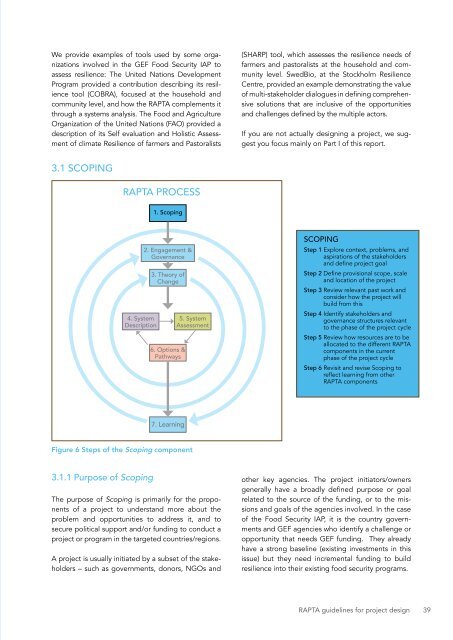DESIGNING PROJECTS IN A RAPIDLY CHANGING WORLD
srun3013fp1
srun3013fp1
Create successful ePaper yourself
Turn your PDF publications into a flip-book with our unique Google optimized e-Paper software.
We provide examples of tools used by some organizations<br />
involved in the GEF Food Security IAP to<br />
assess resilience: The United Nations Development<br />
Program provided a contribution describing its resilience<br />
tool (COBRA), focused at the household and<br />
community level, and how the RAPTA complements it<br />
through a systems analysis. The Food and Agriculture<br />
Organization of the United Nations (FAO) provided a<br />
description of its Self evaluation and Holistic Assessment<br />
of climate Resilience of farmers and Pastoralists<br />
(SHARP) tool, which assesses the resilience needs of<br />
farmers and pastoralists at the household and community<br />
level. SwedBio, at the Stockholm Resilience<br />
Centre, provided an example demonstrating the value<br />
of multi-stakeholder dialogues in defining comprehensive<br />
solutions that are inclusive of the opportunities<br />
and challenges defined by the multiple actors.<br />
If you are not actually designing a project, we suggest<br />
you focus mainly on Part I of this report.<br />
3.1 SCOP<strong>IN</strong>G<br />
RAPTA PROCESS<br />
1. Scoping<br />
4. System<br />
Description<br />
2. Engagement &<br />
Governance<br />
3. Theory of<br />
Change<br />
6. Options &<br />
Pathways<br />
5. System<br />
Assessment<br />
SCOP<strong>IN</strong>G<br />
Step 1 Explore context, problems, and<br />
aspirations of the stakeholders<br />
and define project goal<br />
Step 2 Define provisional scope, scale<br />
and location of the project<br />
Step 3 Review relevant past work and<br />
consider how the project will<br />
build from this<br />
Step 4 Identify stakeholders and<br />
governance structures relevant<br />
to the phase of the project cycle<br />
Step 5 Review how resources are to be<br />
allocated to the different RAPTA<br />
components in the current<br />
phase of the project cycle<br />
Step 6 Revisit and revise Scoping to<br />
reflect learning from other<br />
RAPTA components<br />
7. Learning<br />
Figure 6 Steps of the Scoping component<br />
3.1.1 Purpose of Scoping<br />
The purpose of Scoping is primarily for the proponents<br />
of a project to understand more about the<br />
problem and opportunities to address it, and to<br />
secure political support and/or funding to conduct a<br />
project or program in the targeted countries/regions.<br />
A project is usually initiated by a subset of the stakeholders<br />
– such as governments, donors, NGOs and<br />
other key agencies. The project initiators/owners<br />
generally have a broadly defined purpose or goal<br />
related to the source of the funding, or to the missions<br />
and goals of the agencies involved. In the case<br />
of the Food Security IAP, it is the country governments<br />
and GEF agencies who identify a challenge or<br />
opportunity that needs GEF funding. They already<br />
have a strong baseline (existing investments in this<br />
issue) but they need incremental funding to build<br />
resilience into their existing food security programs.<br />
RAPTA guidelines for project design 39


